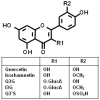Glucuronidated quercetin lowers blood pressure in spontaneously hypertensive rats via deconjugation
- PMID: 22427863
- PMCID: PMC3299686
- DOI: 10.1371/journal.pone.0032673
Glucuronidated quercetin lowers blood pressure in spontaneously hypertensive rats via deconjugation
Abstract
Background: Chronic oral quercetin reduces blood pressure and restores endothelial dysfunction in hypertensive animals. However, quercetin (aglycone) is usually not present in plasma, because it is rapidly metabolized into conjugated, mostly inactive, metabolites. The aim of the study is to analyze whether deconjugation of these metabolites is involved in the blood pressure lowering effect of quercetin.
Methodology/principal findings: We have analyzed the effects on blood pressure and vascular function in vitro of the conjugated metabolites of quercetin (quercetin-3-glucuronide, Q3GA; isorhamnetin-3-glucuronide, I3GA; and quercetin-3'-sulfate, Q3'S) in spontaneously hypertensive rats (SHR). Q3GA and I3GA (1 mg/kg i.v.), but not Q3'S, progressively reduced mean blood pressure (MBP), measured in conscious SHR. The hypotensive effect of Q3GA was abolished in SHR treated with the specific inhibitor of β-glucuronidase, saccharic acid 1,4-lactone (SAL, 10 mg/ml). In mesenteric arteries, unlike quercetin, Q3GA had no inhibitory effect in the contractile response to phenylephrine after 30 min of incubation. However, after 1 hour of incubation Q3GA strongly reduced this contractile response and this effect was prevented by SAL. Oral administration of quercetin (10 mg/Kg) induced a progressive decrease in MBP, which was also suppressed by SAL.
Conclusions: Conjugated metabolites are involved in the in vivo antihypertensive effect of quercetin, acting as molecules for the plasmatic transport of quercetin to the target tissues. Quercetin released from its glucuronidated metabolites could be responsible for its vasorelaxant and hypotensive effect.
Conflict of interest statement
Figures







Similar articles
-
Vascular deconjugation of quercetin glucuronide: the flavonoid paradox revealed?Mol Nutr Food Res. 2011 Dec;55(12):1780-90. doi: 10.1002/mnfr.201100378. Mol Nutr Food Res. 2011. PMID: 22144045
-
Glucuronidated and sulfated metabolites of the flavonoid quercetin prevent endothelial dysfunction but lack direct vasorelaxant effects in rat aorta.Atherosclerosis. 2009 May;204(1):34-9. doi: 10.1016/j.atherosclerosis.2008.08.007. Epub 2008 Aug 14. Atherosclerosis. 2009. PMID: 18801486
-
The flavonoid quercetin induces acute vasodilator effects in healthy volunteers: correlation with beta-glucuronidase activity.Pharmacol Res. 2014 Nov;89:11-8. doi: 10.1016/j.phrs.2014.07.005. Epub 2014 Jul 27. Pharmacol Res. 2014. PMID: 25076013 Clinical Trial.
-
Pharmacology in health food: metabolism of quercetin in vivo and its protective effect against arteriosclerosis.J Pharmacol Sci. 2011;115(4):466-70. doi: 10.1254/jphs.10r38fm. Epub 2011 Mar 24. J Pharmacol Sci. 2011. PMID: 21436601 Review.
-
Antihypertensive effects of the flavonoid quercetin.Pharmacol Rep. 2009 Jan-Feb;61(1):67-75. doi: 10.1016/s1734-1140(09)70008-8. Pharmacol Rep. 2009. PMID: 19307694 Review.
Cited by
-
Metabolic profile of puerarin in rats after intragastric administration of puerarin solid lipid nanoparticles.Int J Nanomedicine. 2013;8:933-40. doi: 10.2147/IJN.S39349. Epub 2013 Mar 4. Int J Nanomedicine. 2013. PMID: 23486407 Free PMC article.
-
Potential Role of Quercetin Glycosides as Anti-Atherosclerotic Food-Derived Factors for Human Health.Antioxidants (Basel). 2023 Jan 23;12(2):258. doi: 10.3390/antiox12020258. Antioxidants (Basel). 2023. PMID: 36829817 Free PMC article. Review.
-
Suppressive effects of quercetin on hydrogen peroxide-induced caveolin-1 phosphorylation in endothelial cells.J Clin Biochem Nutr. 2021 Jul;69(1):28-36. doi: 10.3164/jcbn.20-190. Epub 2021 Apr 3. J Clin Biochem Nutr. 2021. PMID: 34376911 Free PMC article.
-
Potential Implications of Citrulline and Quercetin on Gut Functioning of Monogastric Animals and Humans: A Comprehensive Review.Nutrients. 2021 Oct 25;13(11):3782. doi: 10.3390/nu13113782. Nutrients. 2021. PMID: 34836037 Free PMC article. Review.
-
Flavonoids: Broad Spectrum Agents on Chronic Inflammation.Biomol Ther (Seoul). 2019 May 1;27(3):241-253. doi: 10.4062/biomolther.2019.034. Biomol Ther (Seoul). 2019. PMID: 31006180 Free PMC article. Review.
References
-
- Hertog MG, Hollman PC, Katan MB, Kromhout D. Intake of potentially anticarcinogenic flavonoids and their determinants in adults in The Netherlands. Nutr Cancer. 1993;20:21–29. - PubMed
-
- Sampson L, Rimm E, Hollman PC, de Vries JH, Katan MB. Flavonol and flavone intakes in US health professionals. J Am Diet Assoc. 2002;102:1414–1420. - PubMed
-
- Hertog MG, Feskens EJM, Hollman PCH, Katan MB, Kromhout D. Dietary antioxidant flavonoids and risk of coronary heart disease: the Zutphen Elderly Study. Lancet. 1993;342:1007–1111. - PubMed
-
- Keli SO, Hertog MGL, Feskens EJM, Kromhout D. Dietary flavonoids, antioxidant vitamins, and incidence of stroke: the Zutphen study. Arch Intern Med. 1996;156:637–642. - PubMed
-
- Perez-Vizcaino F, Duarte J. Flavonols and cardiovascular disease. Mol Aspects Med. 2010;31:478–494. - PubMed
Publication types
MeSH terms
Substances
LinkOut - more resources
Full Text Sources
Miscellaneous

